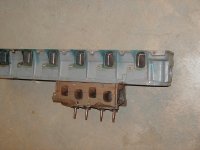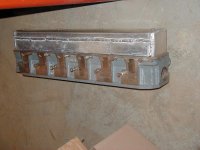You are using an out of date browser. It may not display this or other websites correctly.
You should upgrade or use an alternative browser.
You should upgrade or use an alternative browser.
Blueprint cleveland head
- Thread starter Tbone3366
- Start date
The Cleveland head uses a canted valve design that requires a second set of lifters and pushrods on the head itself to get the correct pushrod angles on a 300 six.
It was done at the time when there weren’t any other options for a large port volume, crossflow 300 head.
Those 300 engines didn't care about power below 4000 rpms.
If the port volumes get too high you won’t be able to make good torque as low as 1000 rpm.
The proper head design looks like the high port heads used on the Ford 7.3 Godzilla engine.
It was done at the time when there weren’t any other options for a large port volume, crossflow 300 head.
Those 300 engines didn't care about power below 4000 rpms.
If the port volumes get too high you won’t be able to make good torque as low as 1000 rpm.
The proper head design looks like the high port heads used on the Ford 7.3 Godzilla engine.
Last edited:
thank you, ill take a look at the 7.3s designThe Cleveland head uses a canted valve design that requires a second set of lifters and pushrods on the head itself to get the correct pushrod angles on a 300 six.
It was done at the time when there weren’t any other options for a large port volume, crossflow 300 head.
Those 300 engines didn't care about power below 4000 rpms.
If the port volumes get too high you won’t be able to make good torque as low as 1000 rpm.
The proper head design looks like the high port heads used on the Ford 7.3 Godzilla engine.
Firepower354
Famous Member
Cleveland is a dinosaur, and besides the awful 400, never saw low rev use.
Gen 4 5.3 LS heads easily exceed the 1-5k demand. So does a CNC ported Promaxx...
Working backwards from power goal, to air mass required, Engines 101 stuff, show a 320cfm head to be wildly excessive.
Godzilla/Gen 5 LT design would need shrinking to work carbed low-rpm application. They make peak torque at 4000, and only pull decent below that, because of long runners and advanced computer setups.
Single point wet flow fuel delivery isn't at all like modern engines are designed around.
If the abilities and facilities existed, beyond speculation, to cast a new head, a clean sheet design would be far better than juggling modern stuff to fit. Then the odd relationship between cylinder bores and lifter bores could be addressed properly. I'd envision exhaust ports on the pushrod side, if even bothering with crossflow.
Gen 4 5.3 LS heads easily exceed the 1-5k demand. So does a CNC ported Promaxx...
Working backwards from power goal, to air mass required, Engines 101 stuff, show a 320cfm head to be wildly excessive.
Godzilla/Gen 5 LT design would need shrinking to work carbed low-rpm application. They make peak torque at 4000, and only pull decent below that, because of long runners and advanced computer setups.
Single point wet flow fuel delivery isn't at all like modern engines are designed around.
If the abilities and facilities existed, beyond speculation, to cast a new head, a clean sheet design would be far better than juggling modern stuff to fit. Then the odd relationship between cylinder bores and lifter bores could be addressed properly. I'd envision exhaust ports on the pushrod side, if even bothering with crossflow.
InlineDave87
Famous Member
I go back and ford with that too cause typically the spark plugs are by the exhaust manifolds but the push rods run between intake ports on v8s… sometimes i wish i was good with computers or drawing so that i could come up with designs to get the most out of these engines… then i also wish i was a billionaire to make my own factory to create my own speed partsIf the abilities and facilities existed, beyond speculation, to cast a new head, a clean sheet design would be far better than juggling modern stuff to fit. Then the odd relationship between cylinder bores and lifter bores could be addressed properly. I'd envision exhaust ports on the pushrod side, if even bothering with crossflow.
Im just doing a sohc casting based on the ford 6.2 super duty motor along with getting cams made by schnieder and prepped, speaking of which i need to send head details to them, should have a casting put together to test by july with a production ready cam for this, of course the manifold faces will be setup to run the stock manifolds with an adapter plate for eachI go back and ford with that too cause typically the spark plugs are by the exhaust manifolds but the push rods run between intake ports on v8s… sometimes i wish i was good with computers or drawing so that i could come up with designs to get the most out of these engines… then i also wish i was a billionaire to make my own factory to create my own speed parts
THE FRENCHTOWN FLYER
5K+
VIP
Subscriber
Supporter 2023
Supporter 2022
Supporter 2021
Supporter 2020
Supporter 2018
The Cleveland head uses a canted valve design that requires a second set of lifters and pushrods on the head itself to get the correct pushrod angles on a 300 six.
It was done at the time when there weren’t any other options for a large port volume, crossflow 300 head.
Those 300 engines didn't care about power below 4000 rpms.
If the port volumes get too high you won’t be able to make good torque as low as 1000 rpm.
The proper head design looks like the high port heads used on the Ford 7.3 Godzilla engine.
Ford addressed those issues and more with their stillborn EFI Crossflow design. Such a pity it didn't come to fruition. It would be a great starting place to produce a next gen 4.9 head for enthusiasts.Cleveland is a dinosaur, and besides the awful 400, never saw low rev use.
Gen 4 5.3 LS heads easily exceed the 1-5k demand. So does a CNC ported Promaxx...
Working backwards from power goal, to air mass required, Engines 101 stuff, show a 320cfm head to be wildly excessive.
Godzilla/Gen 5 LT design would need shrinking to work carbed low-rpm application. They make peak torque at 4000, and only pull decent below that, because of long runners and advanced computer setups.
Single point wet flow fuel delivery isn't at all like modern engines are designed around.
If the abilities and facilities existed, beyond speculation, to cast a new head, a clean sheet design would be far better than juggling modern stuff to fit. Then the odd relationship between cylinder bores and lifter bores could be addressed properly. I'd envision exhaust ports on the pushrod side, if even bothering with crossflow.
Attachments
Did this design make it past prototype casting? What caused them to abandon it?Ford addressed those issues and more with their stillborn EFI Crossflow design. Such a pity it didn't come to fruition. It would be a great starting place to produce a next gen 4.9 head for enthusiasts.
THE FRENCHTOWN FLYER
5K+
VIP
Subscriber
Supporter 2023
Supporter 2022
Supporter 2021
Supporter 2020
Supporter 2018
Yes. Prototype engines were built and tested in vehicles. Even a few turboed vehicles were built.Did this design make it past prototype casting?
Emissions and packaging concerns.What caused them to abandon it?
The big bore 4.9 was a dirty engine, an anachronism in an era where bore sizes were being reduced for cleaner designs.
In the early '90s hoods were geting higher. To package the 4.9 took a lot of hood height.
Enter the V6, the 4.2 L version of the pass car 3.8 L. It was lower, cleaner, lighter, and cheaper to build than upgrading the 4.9 to cleaner standards.
In the interim, the 4.9 got a squirrel cage blower and manifolding to cool the injectors until the 4.2 V6 was ready.
Last edited:
There's a 2007 4.2V6 powering the emergency generator at work. NG fueled and 55 hours on it. I'm not a V6 guy, but I'd snatch up that one, it's still "brand new". At 1800 rpm with the 3" exhaust and shorty fat muffler, sounds remarkably like a semi engine from a moderate distance. Silky smooth.
Similar threads
All Small Six
Power ratings.
- Replies
- 26
- Views
- 1K


